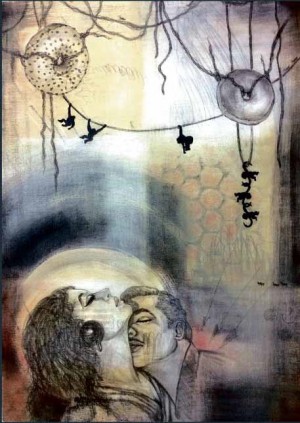
Kitsch sells. It is easily digestible stuff, or visually appealing, so it doesn’t fail to grab buyers—from the ever-popular Mabini art to the best-selling works of some so-called serious artists.
We’re sure people like Jeff Koons and Damien Hirst are serious with their art, but not a few relegate many of their pieces to expensive kitsch.
Trendy among our young artists nowadays is kitsch passed off as high art. They churn out chaotic imagery in hyperrealist rendition and blithely call it “surrealism” or “postmodern.”
The prototype, of course, is Bosch’s “The Garden of Earthly Delights.” But we’re not sure if it’s proper to mention the works of these latter-day Boschs in the same breath with that magnificent opus.
In a piece of the really serious artist, who takes form as indivisible from content, a design, pattern or meaning is perceptible amid the chaos. Confused artists jumble everything on the canvas and call it art—the more outrageous, the better.
Running commentary
Still, there are those who seem to go against the current.
Consider “Reverie,” by Sequi Cu Unjieng, 14 pieces in acrylic, charcoal and oil on canvas, until Sept. 18 in ArtistSpace, GF, Ayala Museum, Makati Ave. cor. De la Rosa St., Greenbelt Park, Makati City.
The pieces are largely monochromatic, the color planes dominated by gray with patches of red and yellow in a few. At a distance, they appear as monochromatic washes and drippings of Abstract Expressionism. On closer look, the viewer sees crude line drawings which jumble Pop Art, Surrealism and Naïf.
The artist doesn’t aspire for photorealism. The illustrations are rather rudimentary, such as the frog on a bicycle balancing giant roses one on top of another in “Puppet Master.”
Or the couple in steamy petting and the silhouettes of monkeys hanging on to a rope tied between two gigantic doughnuts in “Bollywood Love in the Time of Donuts.”
Or the swinging chandelier, spoons and telephone in midair, and live chickens in microwave ovens in “The Chickens Don’t Know.”
The surrealism emerges from the juxtaposition of these illustrative elements. Some may find the pieces kitschy, but the whole exhibit is actually a running commentary on what are prevalent in our culture.
Alternate reality
In “They Came for Shoes,” for instance, an alien spaceship is beaming up numerous high-heeled shoes—and you know what that conjures.
In “Bollywood Love in the Time of Donuts,” one apprehends the monkey business in show business and the trend in our food culture. Going deeper, one may discover that the appetite that generates food addiction is the same that drives sexual craving.
“I Kid You Not” appears to be a spoof of Michelangelo’s fresco of the Creation, with animals substituting for man and divinity.
“I sometimes think that there exists an alternate reality where snippets of our daily experiences and ignored or discarded memories come alive,” says Cu Unjieng. “We see this other cosmos with our eccentric notions and fleeting ideas.”
The artist divides her time between the Philippines and Canada. Mostly self-taught, she attended painting courses at the Emily Carr Institute of Art and Design in Vancouver.
Her preferred medium is acrylic, though sometimes she mixes mediums in her work. This is her third solo show in the country. She had exhibited in Galerie Hans Brumann and Hiraya Gallery.
Her pieces recall the works of Ian Quirante, who, in an exhibit some years ago, found the source of his art-making in the subconscious.
Says Cu Unjieng: “Are dreams peeks into this place we created unwittingly but germinates daily—eyelets on the curtain that conceals our other stories unfolding there?”